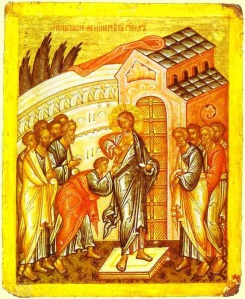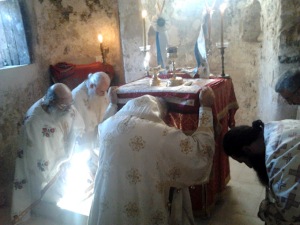Apolytikion
Ἐσφραγισμένου τοῦ μνήματος ἡ ζωὴ ἐκ τάφου ἀνέτειλας Χριστὲ ὁ Θεός, καὶ τῶν θυρῶν κεκλεισμένων, τοῖς Μαθηταῖς ἐπέστης ἡ πάντων ἀνάστασις, πνεῦμα εὐθὲς δι’ αὐτῶν ἐγκαινίζων ἡμῖν, κατὰ τὸ μέγα σου ἔλεος. (γ’)
“THOUGH the grave was sealed, thou didst arise from the sepulchre, O Christ God, who art the Life; and though the doors were fast shut, thou wast present among thy Disciples, who art the Resurrection of all; and through them thou hast renewed a right Spirit in us, in accordance with thy Great Mercy.” (Thrice)
☦

A 15th century Russian icon of the Belief of St Thomas
☦
About This Prayer
THIS PRAYER is the Apolytikion or Dismissal hymn on the Sunday of St Thomas, the Sunday immediately following Easter Day (Pascha), which is also called Antipascha. Jesus, following his resurrection, appeared to his Apostles (though the door of their room was locked) and showed them the proofs of his Passion: the marks of the nails and the cleft in his side where a lance had been thrust to prove that he was dead. St Thomas however was absent, and on returning he would not believe unless he could thrust his finger into the wounds for himself. Jesus appeared a second time, and St Thomas humbly confessed: “My Lord and my God”. See John 20:19-29.
The Sealed Tomb and the Locked Door
Ἐσφραγισμένου τοῦ μνήματος, a genitive absolute, “the grave being sealed off”. The tomb of Jesus was sealed on Pilate’s orders, and placed under armed guard, in the hope that he could head off an attempt to steal the body and claim that Jesus was still alive. This is parallel to τῶν θυρῶν κεκλεισμένων, “the doors being shut”, also a genitive absolute. κεκλεισμένων is a perfect tense participle, implying absolute security, so I’ve added the adverb “fast”.
The Healing Sun Arises
ἀνέτειλας (“you arose”) is from ἀνατέλλω, meaning “I rise”. It is especially suitable for speaking of the rising of the sun, and is the word used by the prophet Malachi when he promises to us, “And unto you that fear my Name a Sun of Righteousness shall arise, and healing shall be in his wings” (Malachi 4:2). Nikitas Stithatos writes movingly of the healing changes to our character which prayer and repentance bring.
FOR those who fear Me, says God, the Sun of righteousness will rise with healing in its wings. They will go forth from the prison-house of the passions and, loosed from the bonds of sin, they will leap like calves. On the day when God restores them they will tread the wicked and the demons under their feet like ashes; for they will be exalted by all the virtues and because of their wisdom and spiritual knowledge they will be made perfect through communion in the Spirit.
“If you search out the Lord and patiently wait for Him until the firstlings of His righteousness grow in you” Nikitas assures us, “you will reap a rich crop of divine knowledge”; we will experience, he writes, “the true fulfillment of the Lord’s words, ‘Rivers of living water will flow from the heart of him who believes in Me’ (John 7:38)”.
Temples of the Spirit
πνεῦμα εὐθὲς ἐγκαινίζων ἡμῖν (“renewing a right Spirit in us”) is a reference to Psalm 50[51],
CREATE in me a clean heart, O God; and renew a right spirit in my inward parts. (Psalm 50:10)
ἐγκαινίζω (“renewing”) can be used to mean an inauguration or dedication ceremony for a holy place. (An εγκαίνια is an inauguration or dedication ceremony.) The word is used, for example, in 3 Kings 8:63, “and the king and all the children of Israel dedicated the house of the Lord”, that is to say, the Temple at Jerusalem. It is also used in this sense in the Epistle to the Hebrews, to speak of the consecration of a new and heavenly Temple through Christ’s Crucifixion, Resurrection, and Ascension (Heb 10:20).

Consecration of a chapel originally founded in 1545, by Metropolitan Seraphim of Kythera and Antikythera. Photo by Stratos Charchalakis.
We could take “renewing” to indicate our consecration as temples of the holy Spirit, as Paul describes us (1 Cor 3:17, 1 Cor 6:19).
KNOW ye not that your body is the temple of the Holy Ghost which is in you, which ye have of God, and ye are not your own? For ye are bought with a price: therefore glorify God in your body, and in your spirit, which are God’s. (1 Cor 6:19)
The prayer closes with κατὰ τὸ μέγα σου ἔλεος, “according to thy great mercy”, from the opening lines of the same Psalm.
The Spirit and the Apostles
The prayer tells us that our renewal comes δι’ αὐτῶν, “through them [the Apostles]”. St John the Evangelist (who was one of the Apostles) tells us that at his first appearance to the Apostles, Jesus breathed the Holy Spirit onto them, not for themselves, but as a commission to found his Church in the world.
THEN said Jesus to them again, Peace be unto you: as my Father hath sent me, even so send I you. And when he had said this, he breathed on them, and saith unto them, Receive ye the Holy Ghost: Whose soever sins ye remit, they are remitted unto them; and whose soever sins ye retain, they are retained. (John 20:21-23)
This is why we do not reject the idea of the Church. Whatever its faults as an institution, whatever the faults of its officers, God chooses to share his Spirit with us through the fellowship of the Church and the ministry of her officers.
A New Spirit, a Pure Heart
The reference to Psalm 50:10 and the making of a clean or pure heart within us brings us back to St Thomas. He was told,
THOMAS, because thou hast seen me, thou hast believed: blessed are they that have not seen, and yet have believed. (John 20:29)
But Jesus also said,
BLESSED are the pure in heart: for they shall see God. (Matthew 5:8)
The Orthodox tradition strongly discourages us from wanting to see Christ with bodily eyes, because the devil can devise lying apparitions to match our images of Christ, leading to delusion (so says St Peter of Damaskos). We sing today,
Νῦν σε Παμβασιλεῦ, ἰδόντες οὐ βλεφάροις, ἀλλὰ καρδίας πόθῳ, Θεὸν πεπιστευκότες, ἐν ὕμνοις μεγαλύνομεν.
NOW do we magnify thee in hymns, O King of All, beholding thee not with our eyelids, but rather, because we have truly believed thee to be God, in the yearning of our hearts.
We see Christ with the eyes of the heart, that is, with the nous, which is how we will see him in the Kingdom to come. As St Theognostos indicates, this inner sight is not a convenient excuse for seeing nothing with the bodily eyes. Those who see Christ with the eyes of the heart experience something far more real and life-changing than an external vision.
NOTHING is better than pure prayer. From it, as from a spring, come the virtues: understanding and gentleness, love and self-control, and the support and encouragement that God grants in response to tears. The beauty of pure prayer is made manifest when our mind dwells in the realm of intelligible realities alone and our longing to attain what is divine is endless.
Then the intellect, tracking its Master through the contemplation of created beings, and ardently thirsting to find and see Him who cannot be seen, or else contemplating the darkness that is His secret place (cf. Ps 18:11), in awe withdraws again into itself, for the moment satisfied and encouraged by the vision revealed to it for its own benefit; but it is full of hope that it will reach the object of its desire when, set free from appearances and the shadow-like fantasies seen indistinctly, as in a mirror, it is granted a pure unceasing vision ‘face to face’ (cf. 1 Cor 13:12).
(St Theognostos, ‘On the Practice of the Virtues, Contemplation and the Priesthood’.)
☦
Christ is risen from the dead, by death trampling down death; and to those in the tombs he has given life. Amen.
“Our sweet Jesus. The only love.” (Elder Joseph the Heyschast.)
